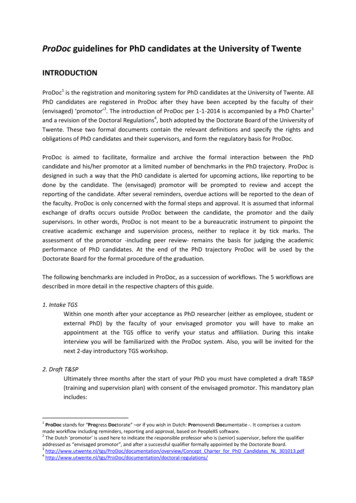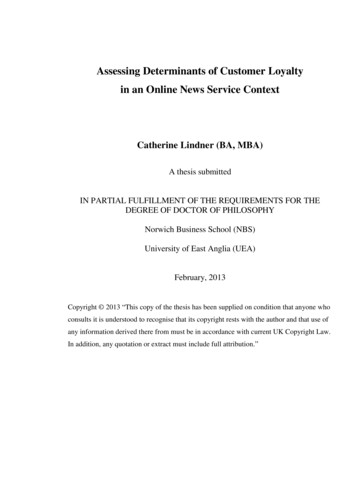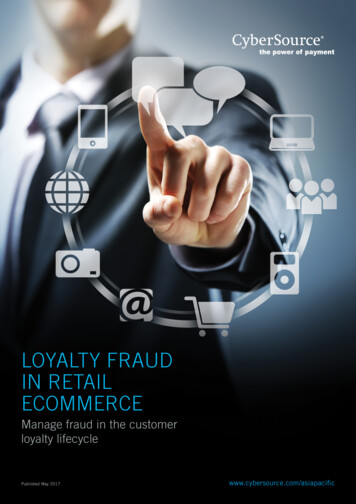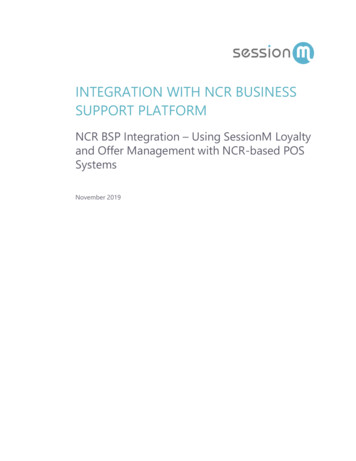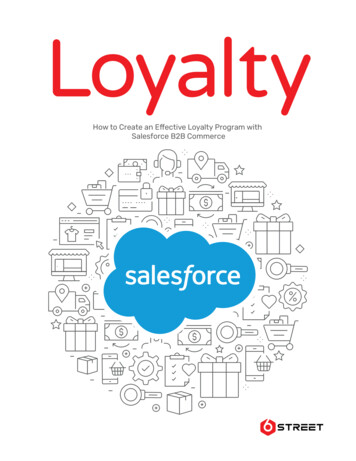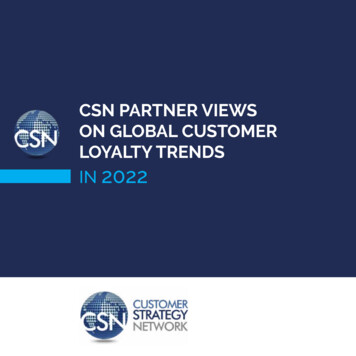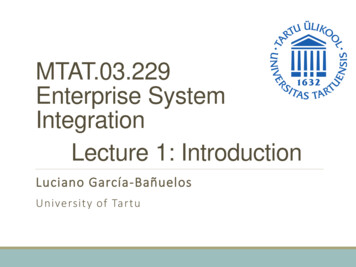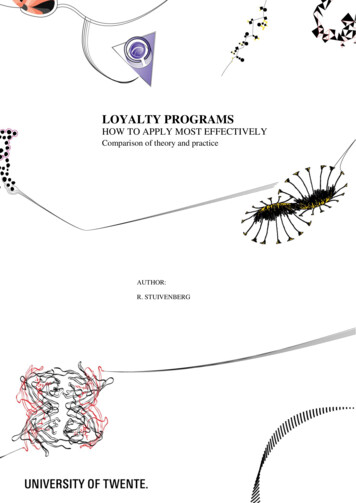
Transcription
LOYALTY PROGRAMSHOW TO APPLY MOST EFFECTIVELYComparison of theory and practiceAUTHOR:R. STUIVENBERG
ColophonDATE 14th of September, 2015PLACE Enschede, the NetherlandsACADEMIC YEAR 2014 / 2015VERSION 1.4PROJECT REFERENCE Master ThesisSTATUS FinalAUTHOR R. Stuivenberg (Robin)STUDENT NUMBER s1502425E-MAIL r.stuivenberg@student.utwente.nlEDUCATION Business Administration (BA)TRACK Service and Change ManagementINSTITUTE University of TwenteFACULTY Behavioral, Management and Social sciences (BMS)EXAM COMMITTEESUPERVISORS UNIVERSITY ir J.W.L. van Benthem, MSc (Jann)dr. R.P.A. Loohuis, MBA (Raymond)I Page
AcknowledgementsThis report is the result of my graduation project for the Master study BusinessAdministration, which is conducted at the University of Twente. I would like to take thisopportunity to thank some people who supported during my research.First I would like to thank my University supervisor’s ir. van Benthem and dr. Loohuis fortheir guidance through the process and critical feedback. This helped me to empower theconstruct of my thesis and to get a clear thesis structure. I would also like to thank thecompanies that opened up their business for me and allowed me to conduct interviews withtheir key employees. Without this field research my thesis would not be as valuable as it is. Aspecial thank you goes out to the company that gave me the possibility to do a five monthduring internship at their company. This experience helped me to improve my skills andprepared me in an optimal way for this research topic. Due to confidentiality reasons I cannotmention names of the companies and managers who contributed to this research.I also would like to thank my fellow graduate students Michel Ophof and Renske Rijpkema.They gave me the chance to discuss matters at any time which led to inspiring advice. Lastbut not least I want to thank my girlfriend, family and friends for their ongoing support duringmy research and their trust in my abilities.Enschede, 14th of September, 2015Robin StuivenbergII P a g e
AbstractThere are a lot of theoretical frameworks and guidelines about how to ensure a loyaltyprogram to be effective (Dowling & Uncles, 1997; Henderson, Beck & Palmatier, 2011;Oliver, 1999; Uncles, Dowling & Hammond, 2003). These frameworks and guidelines alldiffer from each other, they even contradict at some points. In practice companies oftenmisunderstand or misapply loyalty programs (Yi & Jeon, 2003). There is no systematicknowledge about the nuances and processes of which practitioners think that they contributeto an effective loyalty program. This empirical research of qualitative nature combines themost important aspects from literature and tests them in practice. This enables the scatteredframeworks and guidelines to form the first step to unity. It also collects and analyzes thenuances from practitioners concerning the key aspects needed in order to apply a loyaltyprogram most effectively. This research is conducted due to a qualitative field research thatcontains six case studies of varying companies that have an active loyalty program.The results show that there are fourteen key aspects that need to be taking into accountwhen one wants to apply a loyalty program most effectively. The key aspect ‘developingrelationships’ can be considered as the most important aspect. This means that this aspectrequires more attention when applying a loyalty program and striving for effectiveness.Another key aspect that stands out is the aspect ‘creating habits’. However, there are alsonuances to these key aspects. The nuances to the key aspect ‘developing relationships’ varyfrom each other. Whereas one aims to improve current customer relationships, another prefersto build sustainable customer relationships for the long term. Others want to give his/herprivileged customers discounts like any other customer, despite the fact that they alreadyreceive discounts due to former arrangements. There are also more practical nuances likeputting saved points on the customers’ receipt when he/she forgot to bring the card. Word ofmouth advertisement is also mentioned as an important nuance.Concluding it can be said that there are fourteen important key aspects to considerwhen one wants to apply a loyalty program effectively. The most important aspects to takeinto account are ‘developing relationships’ and ‘creating habits’. This research contributes toliterature with its qualitative nature due to the nuances that spice up the results of this study. Italso creates a first structure within the divided research area of loyalty programs. This paper iswritten for anyone who is interested in loyalty programs and in how to apply them mosteffectively in practice. However, it can also be used as a guideline to help practitionersmaking their loyalty program effective; this applies to loyalty programs of any size.III P a g e
Table of ContentsCOLOPHON --------------------------------- IACKNOWLEDGEMENTS ---------------- IIABSTRACT -------------------------------- IIITABLE OF CONTENTS ------------------ IV1.INTRODUCTION ------------------- 11.1.1.2.1.3.1.4.1.5.1.6.1.7.1.8.2.COMPLICATION AND SITUATION ------------------------------------------------ 1RESEARCH ------------------- 2RESEARCH QUESTION --------- 2SUB QUESTIONS --------------- 3RESEARCH APPROACH AND METHODS ----------------------------------------- 3THEORETICAL ------------- 3PRACTICAL CONTRIBUTION --- 3OUTLINE ----------------------- 3THEORETICAL FRAMEWORK -- 52.1.CONSUMER LOYALTY ---------- 52.2.LOYALTY PROGRAMS ---------- 62.3.EFFECTIVENESS ---------------- 62.4.HOW TO APPLY LOYALTY PROGRAMS MOST EFFECTIVELY --------------------- 62.4.1.Social media -------- 112.5.KEY ASPECTS ------------------ 123.METHODOLOGY ----------------- 143.1.3.2.3.3.4.FIELD RESEARCH ----------------- 164.1.4.2.4.3.4.4.4.5.4.6.4.7.4.8.5.RESEARCH APPROACH -------- 14DATA COLLECTION METHOD - 15CASE STUDIES ----------------- 15LOYALTY PROGRAM A -------- 16LOYALTY PROGRAM B -------- 17LOYALTY PROGRAM C -------- 19LOYALTY PROGRAM D -------- 20LOYALTY PROGRAM E -------- 21LOYALTY PROGRAM F -------- 22KEY ASPECTS ------------------ 24NUANCES --------------------- 25RESULTS: COMPARISON OF THEORY AND PRACTICE ------------------- 285.1.SUMMARY OF KEY ASPECTS FROM THEORY AND PRACTICE ------------------- 285.2.COMPARISON OF KEY ASPECTS FROM THEORY AND PRACTICE --------------- 295.2.1.Cautious budget allocating --------------------------------------- 295.2.2.Providing status --- 306.CONCLUSION, DISCUSSION, LIMITATIONS AND CONTRIBUTION --- 326.1.CONCLUSION ----------------- 32IV P a g e
6.1.1.Further research --- ----------------------------------- 356.3.LIMITATIONS ------------------ 366.4.CONTRIBUTION --------------- 37REFERENCES ------------------------------ 39APPENDIX 1: RESEARCH ------- 42APPENDIX 2: INTERVIEW QUESTIONS ---------------------------------------------- 43APPENDIX 3: ELABORATED INTERVIEWS ------------------------------------------ 46V Page
1.IntroductionIn this research loyalty programs are in the centre of attention. In the first chapter thecomplication and situation, including information about the area of topic and why thisresearch is conducted, is described in paragraph 1.1. Followed by the definition of the goals ofthis research in paragraph 1.2. The research questions are listed in paragraph 1.3. andparagraph 1.4. An explanation about how this research is conducted is described in paragraph1.5. The theoretical- and practical contributions of this research are described in paragraph1.6. and paragraph 1.7. Finally the outline of this report is described in paragraph 1.8.1.1.Complication and situationThere are a lot of theoretical frameworks and guidelines about how to ensure a loyaltyprogram to be effective and successful (Dowling & Uncles, 1997; Henderson et al., 2011;Oliver, 1999; Uncles et al., 2003). These frameworks and guidelines all differ from eachother, they even contradict at some points. Therefore there is a lack of consensus in literatureconcerning these frameworks and guidelines. In practice companies often misunderstand ormisapply loyalty programs (Yi & Jeon, 2003). During the process from design toimplementation most business managers see rewards as free gifts handed out on a short-termpromotional basis (O’Brien & Jones, 1995). There is no systematic knowledge about thenuances and processes of which practitioners think that they contribute to an effective loyaltyprogram; what is really important and what is not?In established repeat-purchase markets there is fierce competition between multibrand/multinational/franchise organizations and their brands/products/services (Abid & Ali,2014). Repeat-purchase markets include FMCG (Fast Moving Consumer Goods), retail, foodand beverages, personal services like banking and travel agents, hotels, transport,pharmaceuticals, basic cosmetics and media (Uncles et al., 2003). These organizationscompete on price, product selection, services, location and more (Abid & Ali, 2014). In orderto stay ahead of competitors it is important to attach a positive feeling to brands (Fujiwara &Nagasawa, 2015). This is often been done by conducting content marketing strategies, wherea certain kind of content is getting linked to a brand, product and/or service in order to pullcustomers (Lieb, 2012). With as purpose to give (potential) customers positivebrand/product/service impressions, generate brand engagement and become a reliable source1 Page
of information (Lieb, 2012). A way to achieve this is by applying loyalty programs (VanDoorn et al., 2010).A loyalty program is a reward system designed to reward customers with extra product orsupplementary goods and/or services often based on their purchase history (Oliver, 1999; Yi& Jeon, 2003). Respectively 10 years ago the United States of America had approximately2,250 loyalty programs and 90 percent of the Americans participated in one or more of theseprograms (Berman, 2006). In Canada and the United Kingdom these figures were even higherthan 90 percent (Berman, 2006). Nowadays the USA counts 3.3 billion loyalty programmemberships, this is an average of 29 memberships per household (Carter, 2015).If a loyalty program is being executed effectively, customer loyalty will increase (Sharp &Sharp, 1999). Besides customer loyalty the selling volume and the selling frequency may alsoincrease (Oliver, 1999). Another aspect to take into account is acquiring new customers, thisincidental benefit derives from for example blogging or word-of-mouth advertisement bysatisfied customers (Van Doorn et al., 2010). A company may also apply a loyalty programfor a range of other purposes like: building databases, cross-selling, aiding trade relations,establishing alliances and assisting brand promotions (Uncles et al., 2003). There will be nofurther elaboration on these purposes in this research, but they are taken into account.1.2.Research goalsThe lack of consensus when it comes to theoretical frameworks and guidelines and theabsence of systematic knowledge about important nuances and processes from practice, bothconcerning the application of loyalty programs in its most effective way as described above inthe first paragraph of this research, lead us to the following research goals: To get a better understanding on how to apply a loyalty program in its most effectiveway by means of a systematic literature review (desk research); To get a better view of nuances from practitioners concerning loyalty programs andof how the key aspects from the literature review are applied in practice (fieldresearch).1.3.Research questionTo achieve the goals of this research, a proper research question is required. The mainquestion of this research is listed below: How are loyalty programs being applied effectively in practice and what are the keyaspects?2 Page
1.4.Sub questionsIn order to answer the research question the following sub questions must be answered:1. What are the key aspects needed to apply a loyalty program most effectively,according to literature?2. What are the key aspects and its nuances needed to apply a loyalty program mosteffectively, according to business managers?1.5.Research approach and methodsThis explorative research is executed by conducting a literature review concerning loyaltyprograms. The most important aspects derived from the literature review, of which multipleaspects are based on empirical evidence, are processed into questions for a qualitative fieldresearch. The data is collected due to semi-structured interviews and the research isapproached deductively. The selection process of the interviewees is done by purposivesampling, a non-probability sampling method. To answer the research question the acquireddata from theory and practice are compared to each other. A more detailed description of theresearch approach and the applied strategies and methods can be found in chapter three.1.6.Theoretical contributionThe theoretical contribution of this empirical research is in the unique approach of comparingliterature about the effectiveness of loyalty programs with data from case studies about loyaltyprograms in practice. Due to these case studies managerial nuances about loyalty programscan be added to the investigated literature. These insights may benefit future research aboutloyalty programs especially concerning the applicability and effectiveness of them.1.7.Practical contributionThe practical contribution of this research is a comparison of literature about loyalty programsand the outcome of case studies with active loyalty programs. The practical contribution canbe used by anyone in the field of research or business willing to learn about loyalty programsand can also be used as a guideline on how to apply a loyalty program most effectively.1.8.OutlineIn the first chapter of this research the introduction to this study is described. The theoreticalframework of this research is shown in chapter two. The methodology of this researchincluding the data collection methods and the applied strategies for case selection is explainedin chapter three. In chapter four the field research including multiple case studies is described.3 Page
The results of this research are shown in chapter five. This is done by comparing data fromtheory with data from practice. Finally in chapter six the conclusion, discussion, limitationsand contribution of this research are described.4 Page
2.Theoretical frameworkIn this theoretical framework relevant theory concerning this research is discussed. Startingwith the definitions and explanations of ‘consumer loyalty’, ‘loyalty programs’ and‘effectiveness’ (paragraph 2.1., 2.2. and 2.3.); followed by multiple theories about how toapply loyalty programs most effectively in paragraph 2.4. The elaboration concerning thelatter answers the first sub questions of this research, which is mentioned above in paragraph1.4. This chapter ends with a summary and conclusion of the described theoretical concepts inparagraph 2.5.2.1.Consumer loyaltyThe definition of consumer loyalty has been modified and adjusted heavily in the last fewdecades (Dowling & Uncles, 1997; O’Brien & Jones, 1995; Oliver, 1999; Sharp & Sharp,1997; Uncles et al., 2003; Yi & Jeon, 2003).Yi & Jeon (2003, p. 231) define consumer loyalty “as repeated purchases of particularproducts or services during a certain period of time”. According to Uncles et al. (2003) thereis not a universally agreed definition of consumer loyalty. Instead they use three popularconceptualizations of consumer loyalty based on brand relationship, purchase behavior andpurchase situation.In this research the following definition is used to define consumer loyalty: “a deeply heldcommitment to re-buy or re-patronize a preferred product/service consistently in the future,thereby causing repetitive same-brand or same brand-set purchasing, despite situationalinfluences and marketing efforts having the potential to cause switching behavior” (Oliver,1999, p. 34).McAlexander, Schouten & Koenig (2002) state that consumer loyalty in practice is oftenmisunderstood. This because marketers use strategies and programs to establish and increaseconsumer loyalty based on limited information about the impact and consequences (Dowling& Uncles, 1997; Fournier, Dobscha & Mick, 1998). McAlexander et al. (2002) addressed thisissue by searching for places where loyal consumers could be found and they studied theprocesses that were leading to their loyalty. They found that consumers generate a variety ofrelationships concerning loyalty, which at their turn leads to competitive advantage (Berry,1995; Kalwani & Narayandas, 1995; Peppers & Rogers, 1993).5 Page
2.2.Loyalty programsAccording to Oliver (1999) “loyalty programs are designed to reward repurchasers with extraproduct (e.g., flights) or supplementary goods and services”. “A loyalty program, which isoften called a reward program, is usually introduced to build customer loyalty through theplanned reward scheme based on a customer’s purchase history” (Yi & Jeon, 2003, p. 229).This means that loyalty programs are a way to differentiate one’s products (Yi & Jeon, 2003).“The goal of a loyalty program is to establish a higher level of customer retention in profitablesegments by providing more satisfaction and value to certain customers” (Bolton, Kannan &Bramlett, 2000, p. 95). Loyalty programs are being justified by the positive influence ofincreased consumer loyalty on long-term financial performance (Anderson, Fornell &Lehmann, 1994; Reichheld & Sasser, 1990).2.3.EffectivenessEffectiveness concerning loyalty programs is aboutincreasing consumer loyalty due to a program that isdesigned for this purpose (Sharp & Sharp, 1999).Consumer loyalty in its turn can increase the number ofsales and the sales volume (Oliver, 1999). It may alsogenerate new consumers (Van Doorn et al., 2010). Avisualization about how effectiveness is defined in thisresearch is shown in figure 1.2.4.Figure 1: visualization of effectivenessHow to apply loyalty programs most effectivelyIn the article “Do customer loyalty programs really work?” Dowling & Uncles (1997) presenta guideline on how to design a loyalty program most effectively. Four steps are central in thisguideline, these steps are explained below:1. Design the loyalty program to enhance the value proposition of a product or serviceIt is more worthwhile to let consumers use a program where their benefit increases parallel towhat they buy. Free gifts will only give a short-term boost of loyalty and will possible devaluethe brand over time (Dowling & Uncles, 1997). If a loyalty program is being applied as anelement of the value proposition of a company, the program becomes part of an integratedstrategy that develops sustainable loyalty (O'Malley, 1998).6 Page
2. Fully cost the loyalty programCertain cost concerning a loyalty program are visible for the management (start-up costs,maintenance costs, etc.), other, also called less visible costs by Dowling & Uncles (1997), arecosts that are unable to predict. These costs could be time spend by marketing managers onloyalty program activities. Therefore the allocation of budget to a loyalty program must beconducted cautiously (Dowling & Uncles, 1997; O'Malley, 1998).3. Design a reward scheme that maximizes the buyer’s motivation to make the nextpurchaseRewards schemes should be targeted at different types of consumers. In this way consumerscan determine their profitability when they are participating in a loyalty program, the kind thatsuits their buying behavior best (Dowling & Uncles, 1997). Reinartz & Kumar (2000)generalize the findings of their empirical study about long-life customers, and highlight thatbusiness managers should focus on short- and long term type of customers at the same time,as they both can be highly profitable. This study is conducted in the general merchandiseindustry and consists of a sample of 9,167 American households (Reinartz & Kumar, 2000).4. Consider specific market situations in planningWhen planning to apply a loyalty program one must consider the product or service its marketsituation. There are situations where loyalty programs are not helpful at increasing consumerloyalty. An example of such a situation is when a brand is highly fashionable. This is becausefashion is the key motivator for consumers in this case (Dowling & Uncles, 1997).Their research concludes that competition is a major reason to launch a loyalty program;another reason is to create a demand-pull effect by making the product and/or service moreattractive to distributors. The latter due to the positive relationship between distributioncoverage and market share (Dowling & Uncles, 1997).Uncles et al. (2003) state in their article “Customer loyalty and customer loyalty programs”that the demand-side potential of loyalty programs can be analyzed due to a framework. Thisframework contains three concepts concerning customer loyalty: customer brand acceptance(CBA), customer brand commitment (CBC) and customer brand buying (CBB). These threeconcepts are used because they represent the base case (CBA) and the two most common7 Page
exceptions (CBC and CBB) of customer loyalty in repeat purchase markets. The twoexceptions include: consumers who value function less than psychological and social valueand consumers who show a very low level of loyalty (Uncles et al., 2003). When we look atthe FMCG industry, Uncles et al. (2003) say that customer brand acceptance is most likely tobe the concept that can be linked to brand loyalty. The other two concepts exist but are notwidespread. According to Uncles et al. (2003) behavioral definitions of loyalty differ andtherefore companies should assess their loyalty programs. In their paper, Uncles et al. (2003)present a checklist for managers to help them start and/or evaluate their loyalty program on astrategic level. This checklist consists of four elements with demarcations and questions:(1) Context;(2) Assessing customer loyalty;(3) Assessing loyalty programs;(4) Assessing major traps (Uncles et al., 2003).A more recent study from Evanschitzky et al. (2012) illustrates that commitment has asignificant positive effect on loyalty towards a company. In other words customercommitment contributes to the effectiveness of a loyalty program. The empirical study ofEvanschitzky et al. (2012) is conducted at a, as they call it, large European retailer. Theymailed a questionnaire to 20,000 random customers and had 5,189 usable respondents.Henderson et al. (2011) state that the theoretical underpinnings of many research concerningloyalty programs is based on three specific aspects: status, habits and relationships. Loyaltyprograms change consumer behavior; the sale of a product and/or service applies a certainstatus to customers in comparison with others. Habits, customers build a certain memory towhat have been purchased before and retailers benefit from this. The development ofrelationships with consumers may enlarge the chance of becoming the consumers’ favorite(Henderson et al., 2011). Ou, Shih, Chen & Wang (2011) found a significant positive impactof ‘relationship commitment’ on ‘consumer loyalty’ in their empirical study aboutrelationships. This means “that the higher the relationship commitment, the higher theloyalty” (Ou et al., 2011, p. 202). The study of Ou et al. (2011) is conducted in Taiwan andincluded a survey of 480 observations from department store customers.In the FMCG/retail/food industry this means:8 Page
Table 1: explanation of the aspects status, habits and relationships in the FMCG/retail/food industryStatus:Kivetz &Consumers prefer loyalty programs in which they have a relative advantageSimonson,in obtaining benefits compared with the average consumer. Relative2003advantage is more important than overall value or personal ease.Habits:Wood, 2010Despite actors' predictions about others' behaviors, people in states of highlife change tended to choose unfamiliar, novel items rather than familiar,traditional items, suggesting that life changes inhibit habit performance.Relationships:De Wulf,Consumers' perceptions of relationship investments enhance relationshipOdekerken-quality, a composite of trust, commitment, and satisfaction, which isSchröder &positively associated with behavioral loyalty. Interpersonal communicationIacobucci,has the strongest association with perceived relationship investment.2001Henderson et al. (2011) also mention that if all three aspects are achieved there also must be atotal fit between the aspects. An example of Starbucks is given were their premium rewardsprogram was fulfilling all three aspects but was still discontinued after a while because ofpoor results (Henderson et al., 2011).Oliver (1999) states in his work “Whence Consumer Loyalty” that in order to ensure asuccessful loyalty program an organization must think of three issues: what is loyalty(because of its changing meaning), is loyalty attainable for the organization (because of thedifferences in states of loyalty) and is loyalty profitable (because of the returns to loyalty).The latter of the three issues is empowered by an empirical study of Reinartz & Kumar (2000)in the general merchandise industry. Their findings, derived from a sample of 9,167 Americanhouseholds, show that ‘customer profitability’ is strongly related to ‘customer lifetimeduration’ (Reinartz & Kumar, 2000). This means that the longer the customer lifetimeduration, which can be realized by increasing customer loyalty, the higher the customerprofitability. For all three issues Oliver (1999) listed questio
I P a g e Colophon DATE 14th of September, 2015 PLACE Enschede, the Netherlands ACADEMIC YEAR 2014 / 2015 VERSION 1.4 PROJECT REFERENCE Master Thesis STATUS Final AUTHOR R. Stuivenberg (Robin) STUDENT NUMBER s1502425 E-MAIL r.stuivenberg@student.utwente.nl EDUCATION Business Administration (BA) TRACK Service and Change Management INSTITUTE University of Twente

